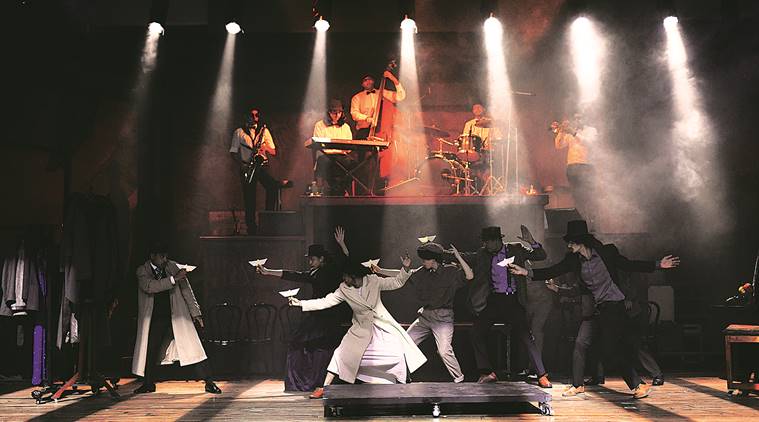Noir Nostalgia
Theatre director Atul Kumar, whose latest play Detective Nau-Do-Gyarah evokes the Bombay of the ’40s, speaks about developing the script and the stage production.

Detective Nau-Do-Gyarah evokes memories of black-and-white noir movies, and is a tribute to to the golden years of Hindi cinema
How inspired are you by Indian cinema of the ’40s and the ’50s?
While growing up in Old Delhi, we loved watching black-and-white movies on television. We would go to our neighbour’s home every Wednesday to watch Hindi film songs. Cinema entered our lives through music and song picturisation. The music then used to be played in local shops, and constantly on radio at home; we were surrounded by it. It refuses to leave us even now.
You have drawn inspiration from a host of things, including graphic novels, gangster films, noir as well as the work of Alfred Hitchcock and Charlie Chaplin.
I haven’t followed any specific genre in graphic novel. I have read noir, Japanese, American and Indian graphic novels. When the comic book Sin City came out and was made into a movie, it did catch my fancy. Gangster and noir movies too have a huge influence on me. I did a film appreciation course at the Film and Television Institute of India (FTII), Pune, twice. I was lucky to have watched movies of Hitchcock, Orson Welles and French noir. I love Indian movies, such as Jaal (1952) and CID (1956). There was a huge influence of western cinema on them. Yet, they had an ingrained Indian-ness. Chaplin’s work, of course, has been an inspiration from the time I started doing theatre.
How did the script of Detective Nau-Do-Gyarah, came about?
The script was developed at the National School of Drama (NSD) when I worked with them last year to create a 40-minute piece. Pallav Singh, who is in second year, created the script from our improvisations. When we decided to make it a one-and-a-half hour piece for Aadyam, we revisited it. We held on to the structure we had created during the NSD production and then elaborated — we needed stronger situations and characters. We introduced new scenes. The play opens with my introduction of the whole concept of man making choices. We also added a dance number in a bar and the character of a moll. Niketan Sharma and Gagan Dev Riar worked on the script. As you can see this play is a khichdi, it is coming together of all these influences. It was not planned. Just like all my theatre journeys, it happened to be.

What made you choose Mumbai of the yore as the setting?
I came to Mumbai from Delhi in 1997. Today, I feel this is my city. When I look at vintage photos of Mumbai, it makes me wonder how the city would have been then. While developing the story with NSD students, we wanted the villain to be on a ship. We couldn’t think of any other place than Mumbai, where he would park his ship and there would be a face-off between the villain and the protagonist. Then, we started looking at everything related to Bombay in that period.
The play has a live jazz band. How did you work on that?
There used to be a lot of swing and jazz bands playing in the background in the movies of that period. Musician Kaizad Gherda was every excited about creating gangster jazz and the tune that could go with the caper treatment on stage. We handpicked different musicians for the band and Kaizad is sort of leading them. We kept sending them recordings of various scenes and they sent us options. We used some, rejected some and developed some of them. They have created something new for the next round of shows.
You have been working more and more with physically-trained actors. What’s the draw for you?
I wish I was working more with physically-trained actors. The problem is not all actors are physically trained. I look back at the actors of my age, 99 per cent of them are not physically fit. I wish I was 20 years younger and could get into the everyday practise of training. In my 20s, I was doing kathakali and kalaripayattu. I’m in love with mime as well as the visual and physical theatre that came out of the Jacques Lecoq tradition (in France). I have also been influenced by Commedia dell’arte (a traditional Italian form of physical comedy) in Italy. Of late, I have been introduced to psycho-physical theatre by Nihaarika Negi. I’m hoping that when I am 70 and if I am still around, I will be able to run and jump.
Your next round of shows is at Royal Opera House that features in your play.

I have never performed at Royal Opera House. The floor space is not very large. So, I don’t know how we are going to fit in. But it’s exciting to adapt the play according to space. We might not use all the set items. If we get the dates for Prithvi Theatre, it would be great to adapt the play to that space. I would love to perform it even in your drawing room for just 25 people with fewer actors and figure out what I have to do to keep the excitement and the visual aspects of the play high.
Detective Nau-Do-Gyarah will be staged at Royal Opera House on Saturday at 7.30 pm; Sunday at 4 pm and 7.30 pm
For all the latest Lifestyle News, download Indian Express App
© IE Online Media Services Pvt Ltd






















No hay comentarios:
Publicar un comentario